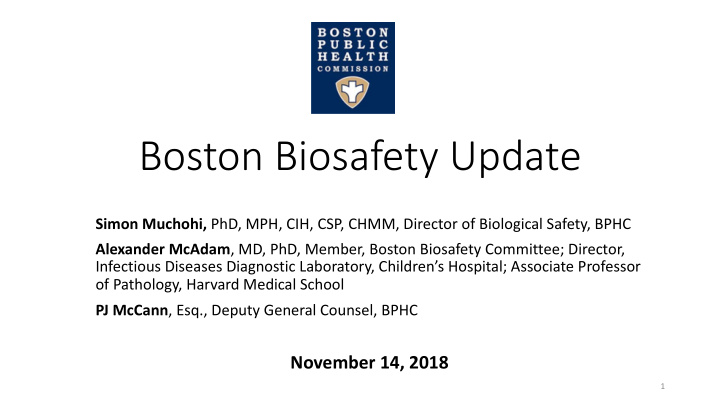



Boston Biosafety Update Simon Muchohi, PhD, MPH, CIH, CSP, CHMM, Director of Biological Safety, BPHC Alexander McAdam , MD, PhD, Member, Boston Biosafety Committee; Director, Infectious Diseases Diagnostic Laboratory, Children’s Hospital; Associate Professor of Pathology, Harvard Medical School PJ McCann , Esq., Deputy General Counsel, BPHC November 14, 2018 1
Boston Biosafety Program in Context Boston n Biosafety Working ng Group up (Emergenc ncy Prepa paredne dness) (EMS, OPHP (EMS, OPHP, BFD , BFD, BPD , BPD, OEM) , OEM) Boston n BIOSAFETY BIOS AFETY City Agenc ncies Biosa Biosafety ty (Sha harps Traini ning ng) PR PROGRA RAM Committee Commit ee BPHC Infectious us Disease Bur ureau (Disease Repo porting ng + Sur urveillanc nce) 2
Biosafety Classifications 3
Goals of Local Oversight 1. Protect the safety and health of lab workers, the public, and the environment 2. Create a uniform set of biosafety requirements for biological research labs in Boston 3. Increase public confidence and awareness of lab safety procedures and regulations 4. Ensure reporting of infectious diseases to BPHC by all labs 5. Apply heightened review and oversight of BSL-4 research 4
BPHC Biosafety Program Role • Permit and inspect academic and biotech laboratory facilities • Review individual research protocols • Review and investigate lab incidents • Participate in Emergency Planning • Conduct Bloodborne Pathogen Trainings • Staff and coordinate Boston Biosafety Committee and Boston Biosafety Working Group • Liaise with internal and external partners 5
Boston Regulatory Framework Recombinant DNA Technology Use Regulations (1994) n Ability to combine DNA molecules ü Useful tool in science, medicine, biotech, agriculture ü 33 entities permitted ü Disease Surveillance and Reporting Regulations (2004) n Healthcare facilities, doctors and labs required to report infectious diseases ü Biological Laboratory Regulations (2006) n Research in BSL3 and BSL4 labs in City of Boston. ü 7 BSL-3 and 1 BSL-4 permitted ü 6
Incident Reporting • Requires reporting any of the following to BPHC upon discovery: • Illness • Spill or accident • Personnel exposure • Unexplained absenteeism • Failure of mechanical system (e.g. ventilation) • Provide follow-up reports to BPHC including: • Occupational health report • Incident investigation 7
Restrictions in Existing Regulations • Incorporate prohibitions, restrictions, and guidelines established at the national level including: • Guidelines for Research Involving Recombinant or Synthetic Nucleic Acid Molecules (NIH Guidelines) • Biosafety in Microbiological and Biomedical Laboratories (BMBL) • Prohibit classified research on high-risk agents • Prohibit weaponization of high-risk agents • Currently, prohibit rDNA work in BSL-4 labs 8
NEIDL Timeline 2012: BPHC approves BSL-2 research at NEIDL 2013: BPHC approves BSL-3 research at NEIDL 2013-2015: BBC meets 12 times to review NEIDL BSL-4 application 2016: CDC approves BSL-4 research at NEIDL 2017: BPHC approves BSL-4 research at NEIDL 2018: NEIDL begins BSL-4 research with Ebola and Marburg 2018: BU submits BSL-4 research additional protocols for review 9
Boston Biosafety Committee (BBC) Role • The BBC is an advisory group created by the Biological Laboratory Regulation • Appointed by the BPHC Executive Director • Made up of at least seven members, including scientific experts and community members • Charged with providing technical assistance related to biosafety policy and permitting labs and projects • Supported by consultants with laboratory safety expertise • Reviews each individual BSL-4 project before approval can be issued by BPHC 10
BBC Review Process to Date • BBC met in August 2018 to review two new BSL-4 research protocols for the NEIDL • Includes a project using rDNA on BSL-4 Select Agents • Generation and use of recombinant filoviruses expressing fluorescent proteins Marburg and Ebola • rDNA fluorescence inactivation technique was recommended by CDC • BBC supported the project and formed a working group to develop a policy recommendation to allow for appropriate rDNA work in the BSL-4 lab • Working group met in October to develop recommendation and appropriate safeguards 11
Boston Biosafety Committee Recommendation 1. Rather than create an ad-hoc waiver from the existing BSL-4 rDNA prohibition, address the rDNA issue at the regulatory level 2. Remove the prohibition on rDNA research on BSL-4 agents in Boston, under the condition that: • Any rDNA project would undergo rigorous approval process for BSL-4 projects • BBC and BPHC review process creates appropriate mechanism for preventing individual BSL-4 research protocols that present any unacceptable risk 3. Streamline the regulatory framework by incorporating rDNA oversight into the Biological Laboratory Regulation and repealing the rDNA Regulation 12
Proposed Amendments q Rescind rDNA Regulation , clarify that Biological Lab Regulation supersedes the 1994 rDNA Regulation and 1981 Ordinance (2.06(a)) q Add: “Research projects using rDNA in BSL-4 laboratories must apply for a permit pursuant to this regulation and will be subject to review by the Boston Biosafety Committee and approval by the Executive Director” (2.06(b)) q Throughout, add “rDNA at BSL 2, 3, or 4” to work that is covered q Revise definitions and citations to align with updated guidance q Incorporate requirement from permit docs that each individual BSL- 4 project undergo review by BBC and approval by BPHC 13
Regulatory Process q Board is authorized to adopt and amend reasonable health regulations under Enabling Act (G.L. c. 111, App. s. 2-7) and state law governing boards of health (G.L. c. 111, s. 31) q Before a vote to approve amendments: q Advertise notice in newspaper q Public hearing and public comment opportunity q Additional outreach to engage stakeholders and community q Additional presentation to the Board summarizing public comment and any further amendments q Board vote q Implementation 14
Recommend
More recommend